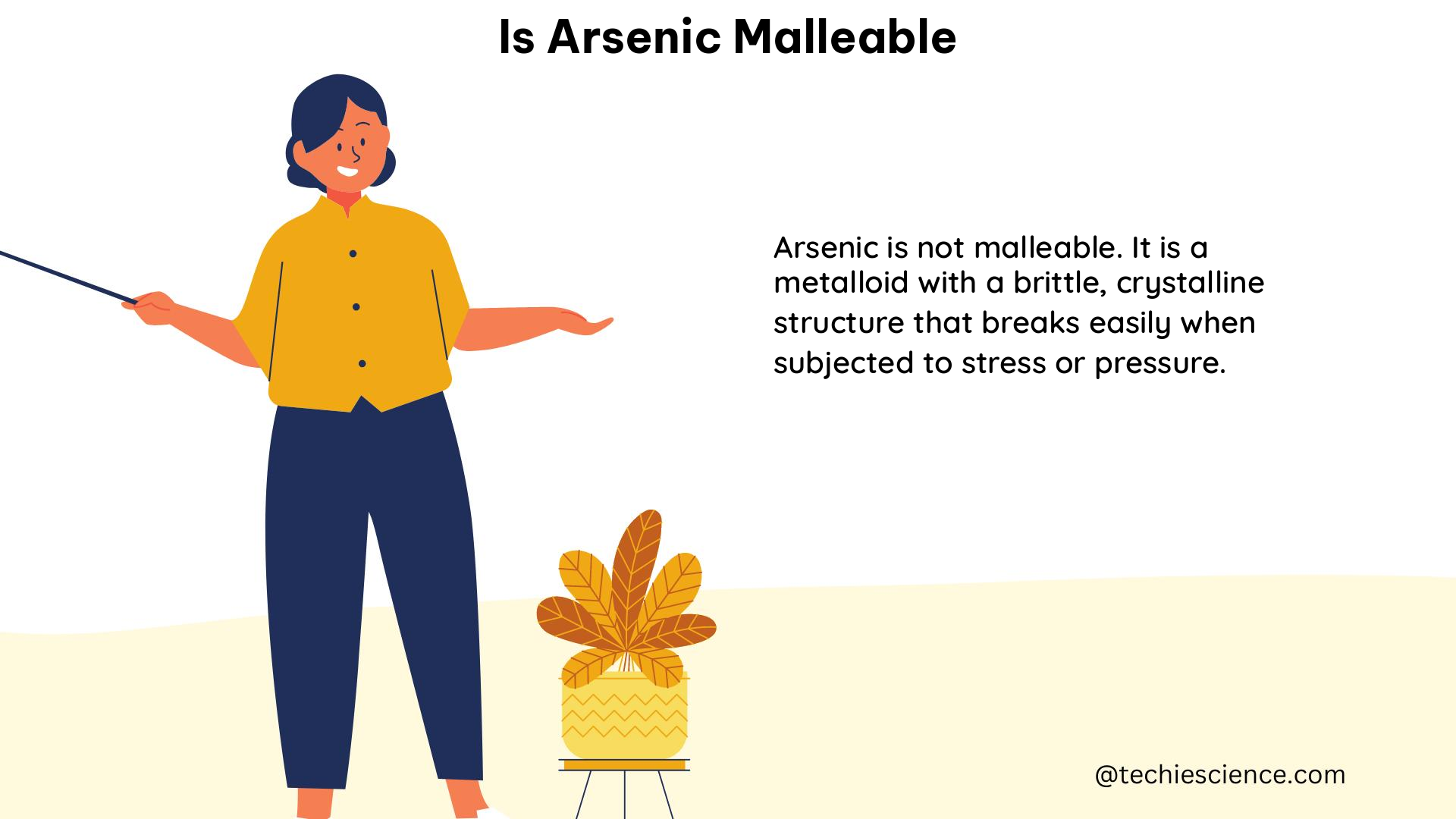Arsenic is a chemical element with the symbol As and atomic number 33. It is a metalloid, which means it has properties of both metals and nonmetals. Contrary to the properties of metals, arsenic is not malleable, which is a characteristic that allows metals to be hammered or pressed into shape without breaking or cracking.
Understanding Malleability
Malleability is a physical property of materials that describes their ability to be hammered, rolled, or pressed into thin sheets without fracturing. This property is primarily observed in metals, as their atoms are arranged in a way that allows them to slide past each other without breaking the crystal structure.
The malleability of a material is determined by the strength of the metallic bonds between its atoms. Metals with strong metallic bonds, such as gold and silver, are highly malleable, while those with weaker bonds, like bismuth and antimony, are less malleable.
Arsenic: A Metalloid with Non-Metallic Properties

Arsenic is classified as a metalloid, which means it exhibits properties of both metals and nonmetals. While some metalloids, like silicon and germanium, can display limited malleability, arsenic is not considered a malleable element.
The reason for this lies in the atomic structure and bonding of arsenic. Unlike metals, where the atoms are arranged in a regular, close-packed crystal structure, the atoms in arsenic are covalently bonded in a more complex, layered structure. This arrangement makes it difficult for the atoms to slide past each other, resulting in a lack of malleability.
Physical Properties of Arsenic
To better understand why arsenic is not malleable, let’s examine its physical properties:
-
Atomic Structure: Arsenic has an atomic number of 33 and an atomic weight of 74.92 g/mol. Its atoms are arranged in a rhombohedral crystal structure, which is a type of trigonal crystal system.
-
Density: Arsenic has a density of 5.72 g/cm³ at 20°C, which is relatively high compared to other metalloids and nonmetals.
-
Melting and Boiling Points: The melting point of arsenic is 817°C (1,503°F), and its boiling point is 613°C (1,135°F).
-
Hardness: Arsenic has a Mohs hardness of 3.5, which is considered relatively soft compared to other elements.
-
Electrical Conductivity: Arsenic is a semiconductor, meaning it has an electrical conductivity that lies between that of a conductor and an insulator.
-
Brittleness: Arsenic is a brittle material, meaning it can easily break or shatter under stress or impact, rather than deforming or bending.
These physical properties, particularly the covalent bonding and layered crystal structure, contribute to arsenic’s lack of malleability.
Comparison to Malleable Metals
To better understand the differences, let’s compare the properties of arsenic to those of some highly malleable metals:
| Property | Arsenic | Gold | Copper |
|---|---|---|---|
| Atomic Structure | Rhombohedral | Face-centered cubic | Face-centered cubic |
| Density (g/cm³) | 5.72 | 19.32 | 8.96 |
| Melting Point (°C) | 817 | 1,064 | 1,085 |
| Hardness (Mohs) | 3.5 | 2.5 | 3.0 |
| Electrical Conductivity | Semiconductor | Excellent conductor | Excellent conductor |
| Malleability | Not malleable | Highly malleable | Malleable |
As you can see, the key differences lie in the atomic structure, density, and overall metallic character of the elements. Metals like gold and copper have a close-packed, regular crystal structure that allows their atoms to slide past each other, enabling malleability. In contrast, the covalent bonding and layered structure of arsenic make it resistant to deformation and prone to brittleness.
Practical Implications of Arsenic’s Non-Malleability
The non-malleability of arsenic has several practical implications:
-
Limited Shaping and Forming: Unlike malleable metals, arsenic cannot be easily hammered, rolled, or pressed into desired shapes or thin sheets. This restricts its use in applications that require extensive shaping or forming.
-
Brittleness and Fragility: The brittleness of arsenic makes it prone to cracking and breaking under stress or impact, limiting its use in applications where mechanical durability is required.
-
Challenges in Metallurgical Processing: The non-malleability of arsenic can complicate metallurgical processes, such as alloying or casting, where the ability to deform the material is often essential.
-
Specialized Applications: Due to its unique properties, arsenic finds specialized applications in the electronics industry, where its semiconductor characteristics are exploited, and in the production of certain pesticides and herbicides.
Conclusion
In summary, arsenic is a metalloid that exhibits properties of both metals and nonmetals. However, unlike many metals, arsenic is not malleable due to its covalent bonding and layered crystal structure. This non-malleability is a result of the specific physical properties of arsenic, which make it resistant to deformation and prone to brittleness. Understanding the reasons behind arsenic’s lack of malleability is crucial for understanding its unique characteristics and potential applications in various industries.
References:
- Environmental Protection Agency (EPA). (2020). Locating and Estimating Sources of Arsenic and Arsenic Compounds. Retrieved from https://www.epa.gov/sites/default/files/2020-11/documents/arsenic_and_arsenic_compounds.pdf
- National Center for Biotechnology Information (NCBI). (n.d.). Distribution of Arsenic in the Environment. Retrieved from https://www.ncbi.nlm.nih.gov/books/NBK231016/
- Agency for Toxic Substances and Disease Registry (ATSDR). (2007). ATSDR Arsenic Tox Profile. Retrieved from https://www.atsdr.cdc.gov/toxprofiles/tp2.pdf
- Periodic Table of Elements. (n.d.). Arsenic. Retrieved from https://www.ptable.com/?lang=en#Property/Atomic%20Structure
- Britannica. (n.d.). Malleability. Retrieved from https://www.britannica.com/science/malleability
Hi, I’m Akshita Mapari. I have done M.Sc. in Physics. I have worked on projects like Numerical modeling of winds and waves during cyclone, Physics of toys and mechanized thrill machines in amusement park based on Classical Mechanics. I have pursued a course on Arduino and have accomplished some mini projects on Arduino UNO. I always like to explore new zones in the field of science. I personally believe that learning is more enthusiastic when learnt with creativity. Apart from this, I like to read, travel, strumming on guitar, identifying rocks and strata, photography and playing chess.